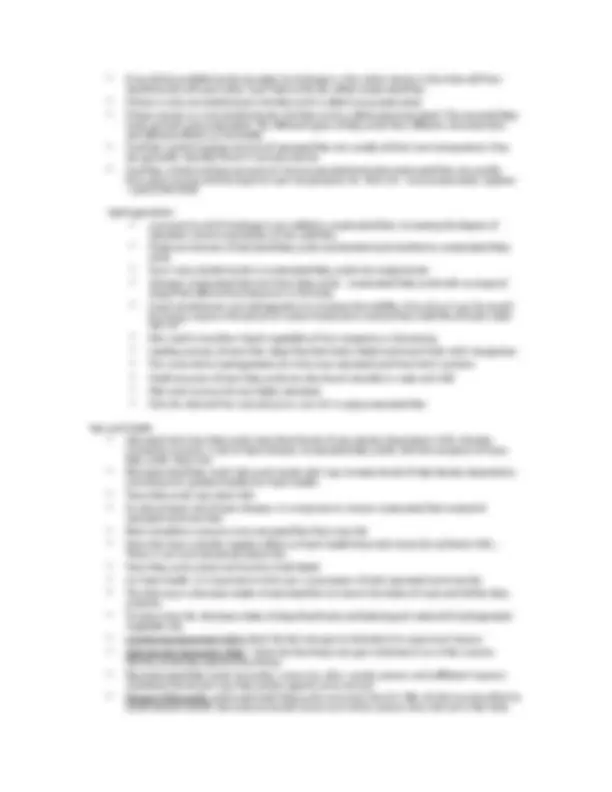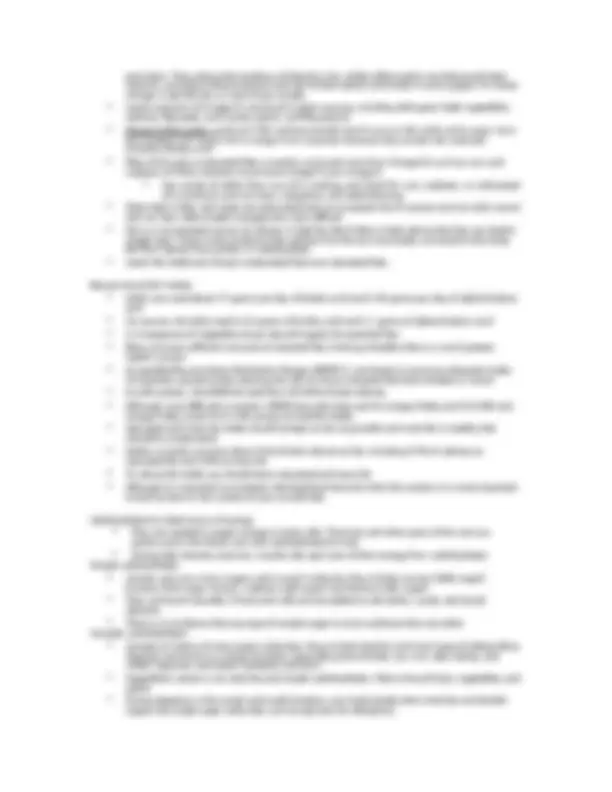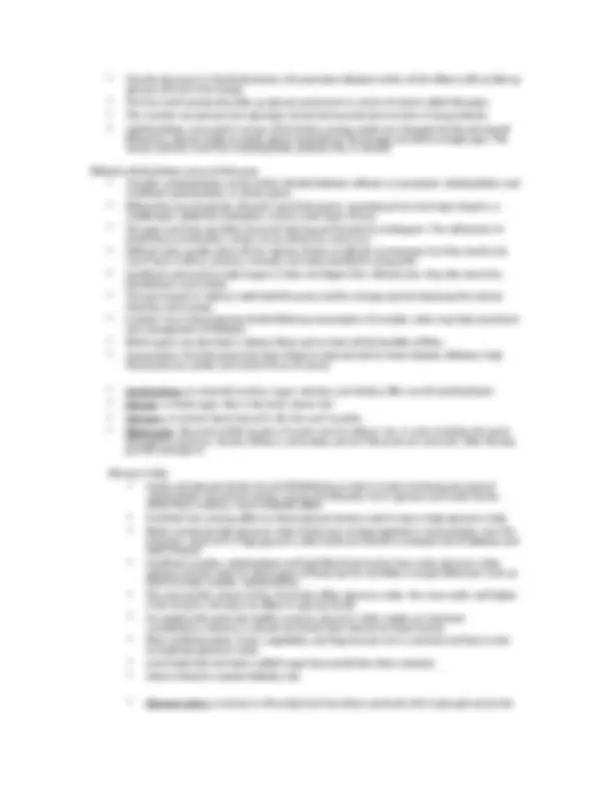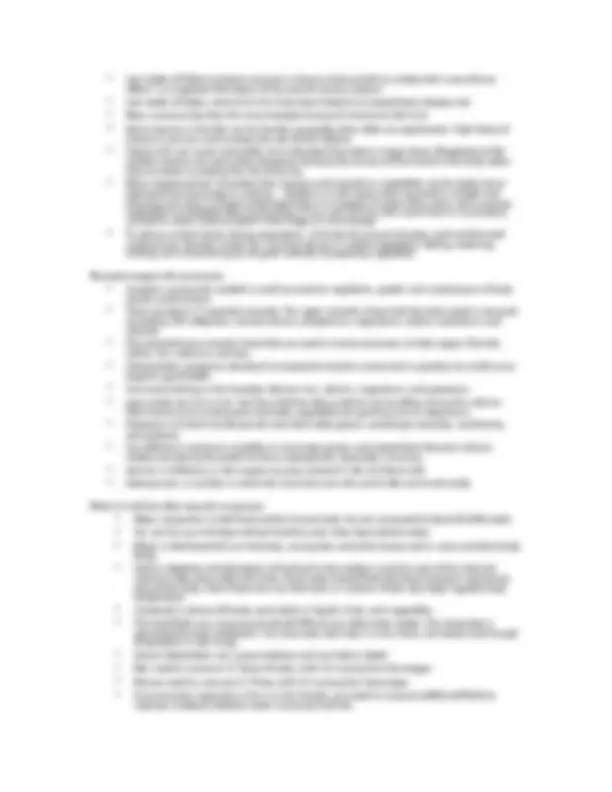Download Essential Nutrients and Their Roles in Human Health and more Study notes Physical Activity and Sport Sciences in PDF only on Docsity!
Chapter 7 : Nutrition The six Classes of essential nutrients
Protein 4 calories / gram
Form important parts of muscles, bone, blood, enzymes, some hormones and cell membranes; repair tissue; regulate water ad acid- base balance, help in growth; supply energy
• meat
• fish
• poultry
• eggs
• milk products
• legumes
• nuts
Carbohydrates 4 calories / gram
Supply energy to cells in brain, nervous system, and blood. Supply energy to muscles during exercise
• Grains
• Fruits
• Vegetables
• Milk
Fat 9 calories / gram
Supply energy, insulate, support and cushion organs Provided medium for absorption of fat-soluble vitamins
• animal products
• grains/nuts/seeds
• fish
• vegetables
Vitamins Promote (initiate or speed up)specific chemical reactions within cells
• fruits and veggies
• grains
• animal products
• dairy
Minerals Helps regulate body functions ; aid in growth and maintenance of body tissues, acts as catalysts for release of energy
• found in most food groups
Water Makes up 50-70% of body weight; provides a medium for chemical fruits, vegetables, and liquid reactions, transports chemicals, regulates temperature, removes waste products
• fruits
• vegetables
• liquids
• The body requires about 45 essential nutrients, meaning that the body must get these nutrients
from food, because the body is unable to manufacture them all, or at least note enough to meet the body’s needs.
• Nutrients are released into the body by the process of digestion, which breaks the nutrients down
into compounds that the gastrointestinal tract can absorb and the body can use.
• Macronutrients: essential nutrients needs in relatively large amounts; fats, protein and
carbohydrates.
• Micronutrients: essential nutrients require in small amount; vitamins and minerals.
• Kilocalories: a measure of energy content in food, 1 kilocalorie represent the amount of heat
needed to raise the temperature of 1 litre of water 1 degree, commonly referred to as a calorie.
• Alcohol, although it is not an essential nutrient it supplies 7 calories per gram ( 0one grams equals
a little less than 0.04 ounce)
• Calories consumed in excess of energy needs can be converted to fat and stored in the body.
The Digestive System
• food is partially broken down be being chewed and mixed with saliva in the mouth
• as food move through the digestive track, it is mixed by muscular contractions and broken down
by chemicals
• after travelling to the stomach via the esophagus, food is broken down further by stomach acids.
• Most absorption of nutrients occurs in the small intestine, aided by secretions from the pancreas,
gallbladder and intestinal lining. The large intestine reabsorbs excess water, the remaining solid wastes are collected in the rectum and excreted through the anus.
Proteins- The Basis of Body Structure
Protein
• Form important parts of the body’s main structural components: muscles and bones
• Also form important pats of blood, enzymes, cell membranes and some hormones
Amino Acids:
• Building blocks of protein
• 20 common amino acids
• 9 amino acids are found in foods – histidine, isoleucine, leucine, lysine, methionine,
phenylalanine, theronine, trytophan, valine
• 11 amino acids can be produced by the body as long as the necessary components are supplied
by foods.
Complete and Incomplete Proteins
Complete Proteins: Supply all the essential amino acids. Meat, Fish , Soy, eggs, cheese, poultry are complete proteins.
Incomplete Proteins: Food that supply most but not all amino acids. Plants , legumes, grains and nuts.
• Adequate daily intake for adults is 0.8 grams per kilogram of body weight.
• Proteins consumed beyond what the body needs is synthesized into fat for energy storage or
burned for energy requirements
• A very high protein intake can strain kidneys and lead to dehydration.
• Adults should eat around 10-30% protein of the total daily calorie intake
Fats- Essential in Small amounts
• The fats stored in your body represent usable energy, help insulate the body and support and
cushion the organs.
• Fats in the diet help the body absorb fat-soluble vitamins and add important flavour and texture of
foods.
• Fats are the major fuel for the body during periods of rest and light activity.
• Two fats – linoleic acids and alpha-linolenic acid are essential to the diet. They are key regulators
of body functions such as blood pressure and healthy pregnancy
Types and sources of fat
• Most of fats in food are in the form of triglycerides, which are composed of glycerine molecule ( an
alcohol) plus three fatty acids.
• A fatty acid is made up of chain of carbon atoms with oxygen attached at the end and hydrogen
atoms attached along the length of the chain.
• Fatty acids differ in the length of their carbon atom chains and in their degrees of saturation
• If every available bond from each carbon atom in a fatty acid chain is attached to a hydrogen
atom, the fatty acid chain is said to be saturated.
acid chain. They reduce the tendency of blood to clot, inhibit inflammation and abnormal heart rhythms, and reduce blood pressure and risk of heart attack and stroke in some people. To crease Omega -3 eat fish two or more times a week.
• Lesser amounts of Omega-3’s are found in plant sources, including dark green leafy vegetables;
walnuts; flaxseeds; and canola, walnut, and flaxseed oil.
• Omega 6 fatty acids: produced if the endmost double bond occurs at the sixth carbon atom (corn
and soybean oil). Foods rich in omega 6 are important because they contain the essential nutruient linoleic acid..
• Most of the poly unsaturated fats currently consumed come from Omega-6’s such as corn and
soybean oil. Most nutrients recommend omega-3 over omega-
• Use canola oil rather than corn oil in cooking, and check for corn, soybean, or cottonseed
oil in products such as mayo, margarine, and salad dressing
• Diets high in fatty red meats are associated with an increased risk of cancers such as colon cancer
and can also make weight management more difficult.
• Fat is a concentrated source of calories. A high-fat diet if often a high-calorie diet that can lead to
weight gain. There is also evidence that calories from fat are more easily converted to the body fat then calories from protein or carbohydrate.
• Lower fat intake and choose unsaturated fats over saturated fats.
Recommend fat intake
• Adult men need about 17 grams per day of linoleic acid and 1.63 grams per day of alpha-linolenic
acid
• For women, the daily need is 12 grams of linoleic acid and 1.1 grams of alpha-linolenic acid
• 3.-4 teaspoons of vegetable oil per day will supply the essential fats
• Most consume sufficient amounts of essential fats, limiting unhealthy fats is a much greater
health concern.
• Acceptable Macronutrient Distribution Ranges (AMDR’s), are based on ensuring adequate intake
of essential nutrients while reducing the risk of chronic diseases like heart disease or cancer
• As with protein, the AMDR for total fat is 20-35% of total calories.
• Although more difficult to monitor, AMDR have also been set for omega 6 fatty acid (6-10%) and
omega-3 fatty acids (0.6-1.2%) as part of total fat intake.
• Saturated and trans fat intake should be kept as low as possible and most fat in healthy diet
should be unsaturated.
• Adults currently consume about 31% of total calories as fat, including 8.7% of calories as
saturated fat and 3.4% as trans fat
• To reduce fat intake you should lower saturated and trans fat
• Although it’s important to evaluate individual food items for their fat content, it is more important
to look at them in the context of your overall diet.
Carbohydrates-An ideal source of energy
• They are needed to supply energy to body cells. The brain and other parts of the nervous
system and in the blood, use only carbohydrates for fuel.
• During high intensity exercise, muscles also get most of their energy from carbohydrates
Simple carbohydrates:
• Contain only one or two sugars units in each molecule; they include sucrose (table sugar),
fructose (fruit sugar, honey), maltose (malt sugar) and lactose (milk, sugar)
• They are found naturally in fruits and milk and are added to soft drinks, candy, and sweet
desserts.
• There is no evidence that any type of simple sugar is more nutritious than any other
Complex carbohydrates:
• Consists of chains of many sugar molecules; they include starches and most types of dietary fibre.
Starches are found in a variety of plants, especially grains (wheat, rye, rice, oats, barley, and millet), legumes, and tubers (potatoes and yam).
• Vegetables contain a mix starches and simple carbohydrates. Fibre is found fruits, vegetables, and
grains
• During digestion in the mouth and small intestine, your body breaks down starches and double
sugars into single sugar molecules, such as glucose, for absorption.
• One the glucose is in the blood stream, the pancreas releases insulin, which allows cells to take up
glucose and use it for energy.
• The liver and muscles also take up glucose and store it in a form of starch called Glycogen.
• The muscles use glucose from glycogen as fuel during endurance events or long workouts.
• Carbohydrates consumed in excess of the body’s energy needs are changed into fat and stored.
Whenever calories intake exceeds calorie expenditure, fat storage can lead to weight gain. The excess calories come from carbohydrates, proteins, fat, or alcohol.
Refined carbohydrates versus whole grain
• Complex carbohydrates can be further divided between refined, or processed, carbohydrates, and
unrefined carbohydrates, or whole grains.
• Before they are processed, all grains are whole grains, consisting of an inner layer of germ, a
middle layer called the endosperm, and an outer layer of bran.
• The germ and bran are often removed, leaving just the starchy endosperm. The refinement of
whole flour to white flour, brown rice to white rice, and so on.
• Refined carbs usually retain all the calories of their unrefined counterparts, but they tend to be
much lower in fibre, vitamins, minerals, and other beneficial compounds.
• Unrefined carbs tend to take longer to chew and digest than refined ones; they also enter the
bloodstream more slowly.
• This pace tends to make to male feel full sooner and for a longer period, lessening the chance
that they will overeat.
• A slower rise in blood glucose levels following consumption of complex carbs may help prevention
and management of diabetes.
• Whole grains are also high in dietary fibres and so have all the benefits of fibre.
• Consumption of whole grains has been linked to reduced risk for heart disease, diabetes, high
blood pressure, stroke, and certain forms of cancer.
• Carbohydrate: an essential nutrient; sugar, starches, and dietary fibre are all carbohydrates
• Glucose: a simple sugar that is the body’s basic fuel
• Glycogen: an animal starch stored in the liver and muscles.
• Whole grain: the entire edible portion of a grain such as wheat, rice, or oats, including the germ,
endosperm, and bran. During milling or processing, parts of the grain are removed, often leaving just the endosperm.
Glycemic Index
• Insulin and glucose levels rise and fall following a meal or snack containing any type of
carbohydrate. Some food causes a quick and dramatic rise in glucose and insulin levels; others have a slower, more moderate effect.
• Food that has a strong effect on blood glucose levels is said to have a high glycemic index.
• Meals containing high glycemic index foods may increase appetite in some people; over the
long term, diets rich in high glycemic index foods are linked to increased risk of diabetes and heart disease.
• Unrefined complex carbohydrates and high-fibre food tend to have a low glycemic index,
patterns are less clear for other types of foods and do not follow a simple distinction such as that of simple complex carbohydrates.
• The acid and fat content of the a food also affect glycemic index- the more acidic and higher
in fat a food is, the lower its effect on glucose levels.
• For people with particular health concerns, glycemic index maybe an important
consideration; however, it should not be the sole criterion for food choices.
• Most unrefined grains, fruits, vegetables, and legumes are rich in nutrients and have a low-
to-moderate glycemic index.
• Limit foods that are high in added sugar but provide few other nutrients.
• Soda is linked to creased diabetes risk.
• Glycemic index: a measure of how high and how fast a particular food raises glucose levels
• To increase fibre in the diet
• Choose whole wheat flour, oats, and rice
• Eat cereal with more than 5 grams of fibre per serving
• Eat whole unpeeled fruit rather than juice
• Include beans in soup and salad. Combine raw vegetables with pasta, rice, and beans in
salads.
Vitamins-Organic Micronutrients
• Organic substances needed in small amounts to help promote and regulate chemical reactions in
processes in the body.
• Humans need 13 vitamins.
• 4 are fat soluble (A,D,E and K)
• 4 water-soluble (C and eight B-complex vitamins:
• Thiamin
• Riboflavin
• Niacin
• Vitamin b-
• Folate
• Vitamin b-
• Biotin
• Pantothenic acid
• Solubility affects how a vitamin is absorbed, transported, and stored in the body.
• Water soluble vitamins are absorbed directly into the bloodstream, where they travel freely;
excess water soluble vitamins are detected and removed by the kidneys and excreted in urine.
• Fat soluble vitamins require a more complex absorptive process: they are usually carried in the
blood by special proteins and are stored in the body in fat tissues rather excreted
Functions of vitamins
• Help chemical reactions take place
• Provide no energy to the body directly but help unleash the energy stored in carbs, proteins and
fats
• They are critical in the production of red blood cells and maintenance of the nervous, skeletal, and
immune systems.
• Some vitamins are also form substances that act as antioxidants, which help preserve healthy
cells in the body. Key vitamin antioxidants include vitamin E, vitamin C, and vitamin A precursor beta-carotene
• Antioxidants: a substance that protects against the breakdown of body constituents by free
radicals; actions include binding oxygen, donating electrons to free radicals, and repairing damage to molecules. Sources of Vitamins
• The body does not manufacture most of the vitamins it requires and must obtain them from
food.
• Vitamins are abundant in fruits, vegetables, and grains.
• Many processed foods, such as flour and breakfast cereal, contain added vitamins
• The skin makes vitamin D when exposed to the sun and intestinal bacteria make vitamin K, but
you still need to obtain vitamin D and K from foods Vitamin deficiencies and Excesses
• If diet lacks sufficient amounts of a particular vitamin, characteristic symptoms of deficiency
develop
• Lack of vitamin A can cause blindness, and vitamin B-6 can cause seizures. Often seen in
developing countries, and is rare in Canada
• Low intake of folate increases a women’s chance of giving birth to a baby with a neural tune
defect ( a congenital information of the central nervous system)
• Low intake of folate, vitamin B-6, B-12 has been linked to increased heart disease risk
• Many consume less than the recommended amount of vitamins A,CB-6 & E
• Extra vitamins in the diet can be harmful, especially when taken as supplements. High doses of
vitamin A are toxic and increase the risk of birth defects.
• Vitamin B-6 can cause irreversible nerve damage when taken in large doses. Megadoses of fat-
soluble vitamins are particularly dangerous because the excess will be stored in the body rather than excreted, increasing the risk of toxicity.
• When preparing food, remember that vitamins and minerals in vegetables can be easily lost or
destroyed during storage or cooking. – riboflavin in milk reacts when exposed to sunlight and thiamine and niacin in bread is destroyed when it is toasted. To retain their value, eat or process vegetables immediately after buying them. If you can’t do this, then store them in a cool place, covered to retain moisture-either in the fridge or in the freezer
• To reduce nutrient losses during preparation, minimize the amount of water used and the total
cooking time. Develop a taste for crunchier texture in cooked vegetables. Baking, steaming, broiling, and microwaving are all good methods of preparing vegetables
Minerals-Inorganic Micronutrients
• Inorganic compounds needed in small amounts for regulation, growth, and maintenance of body
tissues and functions
• There are about 17 essential minerals. The major minerals, those that the body needs in amounts
exceeding 100 milligrams, include calcium, phosphorus, magnesium, sodium, potassium, and chloride
• The essential trace mineral, those that you need in minute amounts, include copper, fluoride,
iodine, iron, selenium, and zinc.
• Characteristic symptoms develop if an essential mineral is consumed in quantity too small or too
large for good health.
• Commonly lacking in the Canadian diet are iron, calcium, magnesium, and potassium.
• Lean meats are rich in iron: low fat or fat free dairy products are excellent choices for calcium.
Plant food such as whole grains and leafy vegetables are good sources of magnesium.
• Potassium-rich food include spinach and other leafy greens, cantaloupe, bananas, mushrooms,
and potatoes.
• Iron-deficiency anemia is a problem in some age groups, and researchers fear poor calcium
intakes are sowing the seeds for future osteoporosis, especially in women,
• Anemia: a deficiency in the oxygen-carrying material in the red blood cells
• Osteoporosis: a condition in which the bones become thin and brittle and break easily.
Water- A vital but often ignored component
• Major component in both food and the human body. You are composed of about 50-60% water
• You can live up to 50 days without food but only a few days without water
• Water is distributed all over the body, among lean and other tissues and in urine and other body
fluids.
• Used in digestion and absorption of food and is the medium in which most of the chemical
reactions take place within the body. Some water based fluids like blood transport substances around the body; other fluids serve as lubricants or cushions. Water also helps regulate body temperature
• Contained in almost all foods, particularly in liquids, fruits, and vegetables.
• The food fluids you consume provide 80-90% of your daily water intake. The remainder is
generated through metabolism. You lose water each day in urine, feces, and sweat and through evaporation in your lungs.
• Severe dehydration can cause weakness and can lead to death
• Men need to consume 3.7 litres of water, with 3.3 coming from beverages.
• Women need to consume 2.7 litres, with 2.2 coming from beverages
• If you exercise vigorously or live in a hot climate, you need to consume additional fluids to
maintain a balance between water consumed and lost.
• Smokers should consume more than 35 mg of vitamin C per day than the DRI intake
level set for their age and sex
• Non smokers are 90mg for men and 75 mg for women. No supplements needed because
the extra vitamins can easily be found in food. One cup of orange juice has about 100 mg of vitamin c Women with heavy menstrual flows may need extra iron to compensate for the monthly loss. Some vegetarians may need supplemental calcium, iron, zinc, and vitamin B-12, depending on their food choices. Newborns need a single dose of vitamin k, which must be administered under the direction of a physician. Many breakfast cereals contain almost as many nutrients as a vitamin pill. If you do decide to take a supplement, choose a balanced formulation that contains 50-100% of the daily value for vitamins and minerals.
• Daily Values: A simplified version of the RDAs used on food labels; also included are values for
nutrients with no established RDA. It represents the appropriate intake levels for a 2000 calorie diet.
Food guide serving and their sizes
• The food group is based on specific serving sizes that may be more or less than your own
typical portion sizes and the serving sizes listed on food labels. It is important to consider the service sizes given if evaluating your diet or planning a dietary change.
Grain products (3-8 servings)
• are usually low in fat and rich in complex carbohydrates, dietary fibre (if grains are
unrefined) and many vitamins and mineral, including thiamin, riboflavin, iron, niacin, folate, and zinc.
• A single serving is equivalent to 1 slice of bread, a small roll, biscuit, or muffin, 30g of
ready to eat cereal, ½ cup cooked cereal, rice, or pasta
• 5-6 small or 2-3 large crackers
• 1 18-cm corn or flour tortilla
• Choose foods made with little fat or sugar over those that are high in fat and sugar.
• For maximum nutrition, choose half if these servings per day from whole grains, such as
whole-wheat bread, high fibre cereal, whole-wheat pasta, and brown rice.
Fruit and vegetables (4-10 servings)
• Rich in carbohydrates, dietary fibre, vitamin A,C, folate, magnesium and other nutrients.
They also naturally low in fat and sodium
• Equivalent to 1 cup raw leafy vegetables, 1 medium sized fruit or vegetable , ½ cup
tomato sauce , ½ cup fruit or vegetable juice , ½ cup cooked dry beans (legumes), 1 cup bean or vegetable soup
• It is important to consume a variety of types to obtain maximum nutrition. Try to
consume at least one serving from each of the following vegetable groups on most days of the week
• Dark green vegetables like spinach, chard, collards, broccoli, romaine, and turnip and
mustard greens
• Deep-yellow and orange vegetables like carrots, winter squash, sweet potatoes, and
pumpkin
• Legumes like pinto beans, kidney beans, black beans, lentil, chickpeas, and tofu;
legumes can be counted as servings of vegetables or as alternatives to meat
• Starchy vegetables like corn, green peas, and white potatoes
• Good choices of fruits are citrus fruits, juices, melons, pears, apples, bananas, and
berries, and whole fruits and typically contain more nutrients and less calories than juices.
Milk and alternatives (2-4 servings)
• High in protein, carbohydrates, calcium, riboflavin, and vitamin D.
• Choose servings low in fat or non fat items such as 1 cup milk, 50g of block cheese, and
2 slices of processed cheese
• 1 cup of cottage cheese counts as only half a serving for this food group
• Dependent upon age and health status
Meat and alternatives (2-3 servings)
• Provides protein, niacin, iron, vitamin B-6, zinc, and thiamin; the animal foods in the
group also provide B-12.
• Serving should be equivalent to 150-300 grams of cooked lean meat, poultry, or fish a
day.
• 50-100g cooked lean meat, poultry or fish
• Portions equivalent to 30 grams of lean meat include ½ cooked dry beans, 1egg, 2
tablespoons peanut butter, 1/3 cup nuts, ¼ cup seeds, and 1/3 cup tofu.
• To limit your intake of fat and saturated fat, choose lean cuts of meat and skinless
poultry, eat nuts and seeds in moderation, and watch your serving sizes carefully.
• Choose at least one serving of such plant proteins as black beans, lentils, or tofu every
day.
Oils and fats which gives advice on foods such as oils and sugars that are not found on the food guide.
A diet using low-fat food choices contains only about 1800 calories but meets all known nutritional needs, except possibly for iron in some women who have heavy menstrual periods.
The vegetarian alternative
• tend to be lower in saturated fat, cholesterol, and animal protein and higher in complex
carbohydrates, dietary fibre, folate, vitamins C and E, carotenoids, and phytochemicals.
• Vegan: a vegetarian who eats no animal products at all
• Lacto-vegetarian: a vegetarian who includes milk and cheese products in diets
• Lacto-ovo-vegetarian: a veg etarian who eats no meat, poultry, or fish, but does eat eggs and milk
products
• Partial vegetarian, semivegetarian or pescovegetarian: a vegetarian who includeseggs, dairy
products, and small amounts of poultry and seafood in their diet
• Food guide for vegetarians
• Grain products group (5-12 servings a day)
• Fruit and vegetables group (5-10 servings per day)
• Milk and alternatives group (0-4 servings per day) or for vegans, dry beans, nuts, seeds,
eggs, and meat substitutes group (2-3 servings per day)
• Daily consumption of a variety of plant foods in amount that meet total energy needs can provide
all needed nutrients, expect for B-12 and possibly Vitamin D
• Vitamin B-12: naturally found only in animal foods; if dairy products and eggs are limited or
avoided, it can be obtained from fortified foods such as ready to eat cereals, soy beverages, meat substitutes, and special yeast products or from supplements
• Vitamin D: obtained by spending 5-15 min. A day out in the sun, by consuming vitamin-d fortified
products like ready to eat cereals and soy or rick milk, or by taking supplements.
• Calcium: found in legumes, tofu processed with calcium, dark green leafy vegetables, nuts,
tortillas made from lime processed corn, and fortified orange juice, soy milk, bread, and other foods
• Iron: found in whole grain, fortified bread and breakfast cereals, dried fruits, green leafy
vegetables. The iron in plant foods is more difficult for the body to absorb than the iron from animal sources; vitamin c helps improve iron absorption
• Zinc: found in whole grains, nuts, legumes, and soy foods
Dietary challenges for special population groups
• Women: lower energy needs therefore consume less calories. They have more difficulty getting
adequate amounts of all the essential nutrients and need to focus on nutrient-dense foods.
• Campylobacter jejuni in meat and poultry
• Listeria monocytogenes in lunch meats, sausages and hot dogs
• Most cases are due to poor handling of the food
• Food irradiation: the treatment of foods with gamma rays, x rays, or high voltage electrons to kill
potentially harmful pathogens and increase shelf life
• Organic: a designation applied to food grown and produced according to strict guidelines limiting
the use of pesticides, nonorganic ingredients, hormones, antibiotics, genetics engineering, irradiation, and other practices.
• They are not chemical free






















